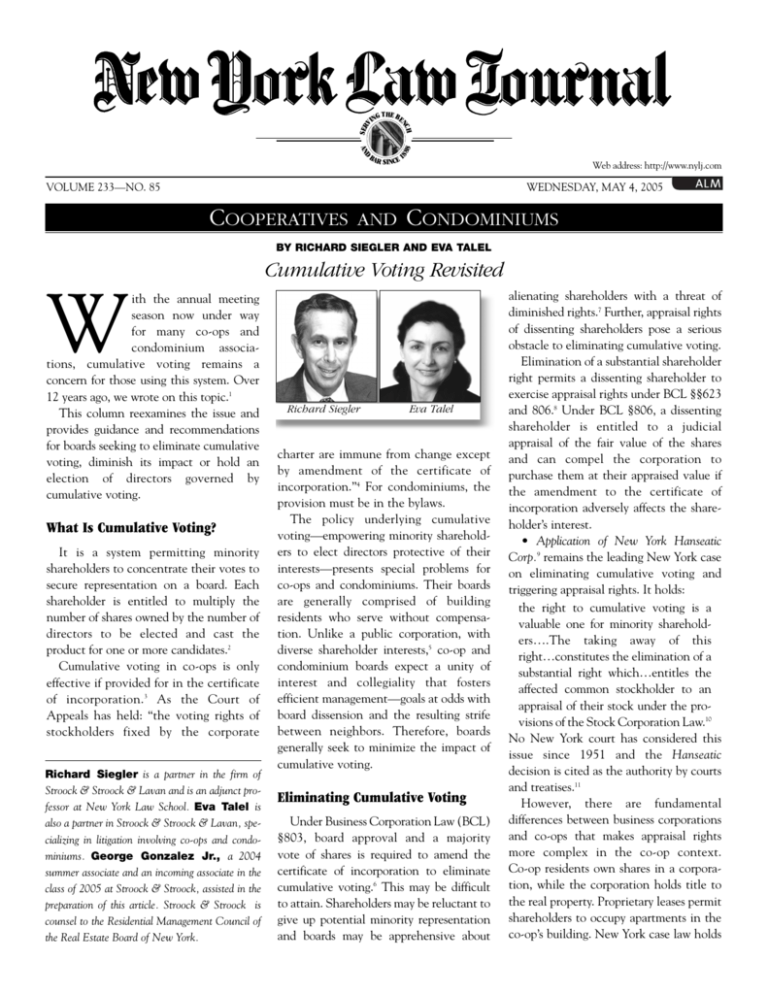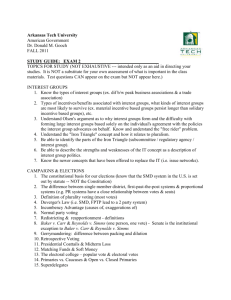
AND
88
8
SER
V
H
NC
THE BE
ING
BA
R SINCE 1
Web address: http://www.nylj.com
VOLUME 233—NO. 85
WEDNESDAY, MAY 4, 2005
COOPERATIVES
AND
CONDOMINIUMS
BY RICHARD SIEGLER AND EVA TALEL
Cumulative Voting Revisited
W
ith the annual meeting
season now under way
for many co-ops and
condominium associations, cumulative voting remains a
concern for those using this system. Over
12 years ago, we wrote on this topic.1
This column reexamines the issue and
provides guidance and recommendations
for boards seeking to eliminate cumulative
voting, diminish its impact or hold an
election of directors governed by
cumulative voting.
What Is Cumulative Voting?
It is a system permitting minority
shareholders to concentrate their votes to
secure representation on a board. Each
shareholder is entitled to multiply the
number of shares owned by the number of
directors to be elected and cast the
product for one or more candidates.2
Cumulative voting in co-ops is only
effective if provided for in the certificate
of incorporation.3 As the Court of
Appeals has held: “the voting rights of
stockholders fixed by the corporate
Richard Siegler is a partner in the firm of
Stroock & Stroock & Lavan and is an adjunct professor at New York Law School. Eva Talel is
also a partner in Stroock & Stroock & Lavan, specializing in litigation involving co-ops and condominiums. George Gonzalez Jr., a 2004
summer associate and an incoming associate in the
class of 2005 at Stroock & Stroock, assisted in the
preparation of this article. Stroock & Stroock is
counsel to the Residential Management Council of
the Real Estate Board of New York.
Richard Siegler
Eva Talel
charter are immune from change except
by amendment of the certificate of
incorporation.”4 For condominiums, the
provision must be in the bylaws.
The policy underlying cumulative
voting—empowering minority shareholders to elect directors protective of their
interests—presents special problems for
co-ops and condominiums. Their boards
are generally comprised of building
residents who serve without compensation. Unlike a public corporation, with
diverse shareholder interests,5 co-op and
condominium boards expect a unity of
interest and collegiality that fosters
efficient management—goals at odds with
board dissension and the resulting strife
between neighbors. Therefore, boards
generally seek to minimize the impact of
cumulative voting.
Eliminating Cumulative Voting
Under Business Corporation Law (BCL)
§803, board approval and a majority
vote of shares is required to amend the
certificate of incorporation to eliminate
cumulative voting.6 This may be difficult
to attain. Shareholders may be reluctant to
give up potential minority representation
and boards may be apprehensive about
alienating shareholders with a threat of
diminished rights.7 Further, appraisal rights
of dissenting shareholders pose a serious
obstacle to eliminating cumulative voting.
Elimination of a substantial shareholder
right permits a dissenting shareholder to
exercise appraisal rights under BCL §§623
and 806.8 Under BCL §806, a dissenting
shareholder is entitled to a judicial
appraisal of the fair value of the shares
and can compel the corporation to
purchase them at their appraised value if
the amendment to the certificate of
incorporation adversely affects the shareholder’s interest.
• Application of New York Hanseatic
Corp.9 remains the leading New York case
on eliminating cumulative voting and
triggering appraisal rights. It holds:
the right to cumulative voting is a
valuable one for minority shareholders….The taking away of this
right…constitutes the elimination of a
substantial right which…entitles the
affected common stockholder to an
appraisal of their stock under the provisions of the Stock Corporation Law.10
No New York court has considered this
issue since 1951 and the Hanseatic
decision is cited as the authority by courts
and treatises.11
However, there are fundamental
differences between business corporations
and co-ops that makes appraisal rights
more complex in the co-op context.
Co-op residents own shares in a corporation, while the corporation holds title to
the real property. Proprietary leases permit
shareholders to occupy apartments in the
co-op’s building. New York case law holds
NEW YORK LAW JOURNAL
that co-op leaseholds and share interests
are inseparable.12
When shareholders turn in their shares
to the co-op after an appraisal, they must
also relinquish occupancy of their
apartment. Is the co-op then obligated
to pay the fair market value of the
apartment, i.e., the shares plus the leasehold? No New York court has decided
whether elimination of cumulative voting
in a co-op triggers appraisal rights.
However, the possibility that appraisal
rights may be invoked is a strong
deterrent to co-op boards seeking to
eliminate cumulative voting.
A board may consider seeking a
declaratory
judgment
determining
whether elimination of cumulative voting
triggers appraisal rights. In Standard
Brewing Co. v. Peachey,13 the court held
that such a judgment was “practical and
useful [and] would permit the plaintiff
corporation to chart its future course with
a knowledge of its rights and liabilities.”14
However, a board should consider the
potentially high cost of such a proceeding
and whether eliminating of cumulative voting is an appropriate use of
corporate funds.
In condominiums, unit owners do not
own shares in the condominium association. Therefore, no appraisal rights are
triggered if cumulative voting is
eliminated. However, doing so requires a
two-thirds vote of unit owners to amend
the bylaws15 which may be difficult to
attain. Short of eliminating cumulative
voting, boards can implement strategies
that reduce its impact.
The Staggered Board
“Classification” or “staggering” of
directors is one method of minimizing the
impact of cumulative voting. BCL §704
permits the certificate of incorporation
or a bylaw adopted by shareholders to
provide that directors may be divided into
two, three or four classes, as equal in
number as possible.16 The term of the first
class initially classified expires at the next
annual meeting; the second class at the
second annual meeting; and so on. After
WEDNESDAY, MARCH 2, 2005
the initial classification, each director
serves for the same number of years as
there are classes. This means that each
year, only one-half, one-third or
one-quarter of the board is up for
election. By reducing the number of
directors elected at one time, the
likelihood that minority shareholders can
elect a director by cumulating votes is
mathematically reduced.
Last-minute floor nominations from
minority shareholders can defeat a
board’s strategy to elect the maximize
number of directors. This is best dealt
with by a bylaw requiring nomination of
all candidates at a specified time prior to
the election —for example, seven days
before the meeting—by written notice
to the co-op’s secretary. The board
then knows who is running and can
determine for whom to cast its votes.
The majority may also be able to maintain control by taking a “second look”
after all votes have been cast, but before
the polls are declared closed. New York
law gives shareholders and proxies the
right to change their votes until the polls
are declared closed. Theoretically, after
the votes have been cast, but before the
polls are closed, management may take a
“second look” at the voting results and
adjust its votes accordingly.
While there is no legal authority to
support or condemn this approach, it
appears unfair to shareholders who do
not control closing the polls and who
anticipate that votes will be counted as
originally cast. Board members considering this approach must be cognizant of
possible undesirable consequences—a
court challenge by dissident shareholders, legal expenses and ill-will and
contention among shareholders.
Proxies
Before the election, management
should prepare a strategy that accounts
for the uncertainties and procedural
hurdles of an election under cumulative
voting. New York law does not require
shareholders to notify management that
they intend to vote cumulatively.
Therefore, a board should craft
the wording of its proxy solicitation to
give it maximum flexibility during
the election.17
Proxies should not require the holder
to vote only one way. In Heffner v. Union
National Bank and Trust Co.,18 the proxy
committee for the management slate of
directors determined to give fewer votes
to certain candidates to maximize the
number of slate members elected. The
U.S. Court of Appeals for the Third
Circuit held that proxies stating that
votes would be cast for the 15 listed
candidates did not confer authority to
vote for only 13 of those 15. Imprecise
language in management’s proxy defeated
its strategy. A broad grant of power will
also avoid questions of irregularity if
proxy holders change strategy during
the election. The slightest appearance
of irregularity may invite a challenge
to an election.19
To avoid such problems, the proxy
statement and the proxy itself should
clearly state that proxy holders may
apportion their votes in any manner
they see fit, using language similar to
the following:
If no contrary instruction is indicated, proxies in the enclosed form will
be voted at the meeting for any or all
of the nominees above. Should the
number of votes given to the proxy
holders selected by the Board permit
the election of less than all of these
individuals, the proxy holders will
vote the shares for those whom the
proxy holders, in their discretion,
believe can best serve the
Corporation, unless instructions to
the contrary are provided by the
shareholder on the proxy. (This
means that the proxy holders may
cast all votes for a single director or
may distribute them among any two
or more of them as the proxy holders
see fit, up to the maximum number to
be elected.)
Voting Formulas
Under cumulative voting, shareholders
NEW YORK LAW JOURNAL
may cast all of their votes for one
candidate or distribute their votes among
the directors to be elected. The formula
to determine the number of shares
necessary to elect a majority of directors
Table 1
X =
Y x N1
N+1
+ 1
X — # of shares needed to elect a given #
of directors
Y — total # of shares at meeting
N1 — # of directors desired to elect
N — total # of directors to be elected
is shown in Table 1.
The formula to determine how many
directors can be elected by a group
controlling a certain number of shares
Table 2
X =
X x (D+1)
S
N — # of directors that can be elected
X — # of shares controlled
D — total # of directors to be elected
S — total # of shares that will be voted at meeting
is shown in Table 2.
For example, assume there are 33,396
outstanding shares and nine directors to
be elected. If all shares are voted, 3,341
votes would be needed to elect one
director, 6,680 votes to elect two
directors, and so on. If a group of
shareholders controls 17,000 votes, they
would be able to elect five directors.
However, with a staggered board, the
number of votes required to elect a single
director is markedly higher. Assume a
nine-member board divided into four
classes, with three classes of two members
and one class of three members.
Assuming that 33,396 shares are voted,
11,132 votes would be needed to elect a
director in a class of two and 8,349 votes
to elect a director in a class of three.
Thus, electing one director in a class
of two members would require almost
34 percent of total votes and 25 percent
of total votes in a class of three
members, a difficult undertaking for
minority shareholders.
Before the election, it is advisable for
WEDNESDAY, MAY 4, 2005
boards to make calculations based upon
several different permutations to ensure
mistake-free voting. However, before any
calculations can reliably be made, it is
essential to know the number of shares
that will be voted. It is, therefore, critical
to obtain a final count of shares present
and voting at the election portion of the
co-op or condominium voting, because
shareholder or unit owners may come and
go as the meeting progresses. The best way
to do so is to require a role call of those
present and meeting, in person or by
proxy, immediately preceding the election
portion of the meeting.
Co-ops and condominium associations
will have great difficulty in eliminating
a cumulative voting system. However,
following recommended strategies
can limit its impact. First, bylaws
should be amended to provide for
staggered boards, thereby substantially
increasing the number of votes
required
to
elect
a
director.
Bylaws should also be amended
to require advance notice of nominations. This will identify all candidates
and allow boards to reliably determine
how best to cast their votes.
Lastly, proxies should be crafted to
give boards maximum flexibility to
achieve the goals of the shareholders
they represent.
••••••••••••••
•••••••••••••••••
1. See, Siegler, “Cumulative Voting,” NYLJ, Jan. 8,
1992 at 3, col. 1. There have been few new legal developments in this area. However, a meaningful number of coops are governed by cumulative voting and the need for
guidance by their boards and managing agents warrants revisiting the issue.
2. 3 White, New York Corporations, §618.02-03.
3. N.Y. Bus. Corp. Law §704(a) (McKinney 2003). See
also, e.g., Christal v. Petry, 275 A.D. 550 (2d Dept. 1949),
aff’d, 301 N.Y. 562 (1950); Matter of American Fibre Chair
Seat Corp., 265 N.Y. 416 (1934). An exception to the general rule is Thistlewaite v. Thistlewaite, 101 N.Y.S.2d 679
(Sup. Ct. Monroe Co. 1950), where cumulative voting
was provided for only in the bylaws. There, the
court required the directors to amend the certificate
to allow for such voting because the bylaws stated:
“the shareholders hereby agree with each other to execute
any papers or to do any act necessary to give legal
effect to the above provision as to cumulative
voting.” 101 N.Y.S.2d at 681. Without similar
language, a bylaw providing for cumulative voting
will be invalid.
4. Matter of American Fibre Chair Seat Corp., 265 N.Y.
416, at 422.
5. Although it originated in the public corporation,
cumulative voting is almost unheard of in the modern corporate setting, notwithstanding periodic calls for its rein-
statement. See, e.g., Jeffrey N. Gordon, “Institutions as
Relational Investors: A New Look at Cumulative Voting,”
94 Colum. L. Rev. 124 (1994).
6. N.Y. Bus. Corp. Law §803(a) (McKinney 2003 &
Supp. 2005).
7. See, Siegler, “Modern, Flexible By-Laws,” NYLJ, May
2, 1990 at 3, col. 1.
8. N.Y. Bus. Corp. Law §623 (McKinney 2003), sets
forth detailed procedural requirements in connection with
the enforcement of appraisal rights. Note that the failure
of a dissenting shareholder to strictly comply with each of
these procedural requirements is grounds for immediate
dismissal of the claim, unless the New York Supreme
Court, for good cause shown, directs otherwise.
9. 200 Misc. 530 (Sup.Ct. King’s Co. 1951).
10. Id. at 536. Hanseatic was decided under the Stock
Corporation Law, the predecessor to the BCL. However
the legislative history to BCL §806 indicates an intention
to continue the existing case law. See BCL §806,
Historical and Statutory Notes (McKinney 2003), citing
to a note appended to L.1966, c.869, which provides:
“This bill (amending this section) restores the law to what
is was under §38(11) of the (former) Stock Corporations
Law. It neither expands nor diminishes the right of
appraisal as established in such section and as construed by
the applicable case law.”
11. See e.g., Brill et. al. v. Certificate Associates, Inc. et.
al., 281 A.D. 532 (1st Dept. 1953); Sears Roebuck &
Company, SEC No-Action Letter, 1993 WL 8574; 14A
N.Y. Jur. 2d Business Relationships §858; Lorenzo’s N.Y.
Condo & Coop. Law §3:15; 7A Fletcher Cyc. Corp. §3697
(Perm. Ed.).
12. New York State Tax Commission v. Shor, 43 N.Y.2d
151 (1977).
13. 202 Misc. 279 (Sup. Ct. Monroe Co. 1951).
14. Id. at 283.
15. N.Y. Real Prop. Law §339 v1(a)(j) (McKinney
1989).
16. N.Y. Bus. Corp. Law §704(a) (McKinney 2003).
17. Unless the bylaws establish specific requirements,
proxies do not require any particular wording; all that is
required is that they be in writing, and that they show the
intention to give the proxy holder the power to vote on
behalf of the shareholders. Prince v. Albin, 23 Misc. 2d 194
(Sup. Ct. N.Y. Co. 1960). If the bylaws provide for voting
by proxy, the board may not impose additional requirements without amending the bylaws. Brodsky v. Board of
Mgrs. of Dag Hammarskjold, 1 Misc. 3d 591 (Sup. Ct. N.Y.
Co. 2003) (board may not require proxies to be acknowledged where bylaws provide that proxies need only be in
writing, signed and dated). As agent of the shareholder,
the proxy holder must vote according to the shareholder’s
instructions.
18. 639 F.2d 1011 (3d Cir. 1981).
19. Dissident shareholders wishing to challenge an election of directors must follow the procedures of BCL §619.
There is a statutory limit of four months, under N.Y. CPLR
§217, in which the shareholder can make this challenge.
See, e.g., Springut v. Don & Bob Restaurants of America
Inc., 57 A.D.2d 302, 304-305 (4th Dept. 1977). If the
alleged improprieties on the part of the incumbent board
are established and were significant, and the election
results would have been different had the alleged improprieties not occurred, the court can direct a new election.
Vallone v. First Women’s Bank, 92 A.D.2d 799 (1st Dept.
1983), citing Carter v. Muscat, 21 A.D.2d 543 (1st Dept.
1964). Generally, courts have held that small irregularities
in the vote will not be enough to set an election aside if
the results would have been the same had the voting procedures been scrupulously adhered to. Schmidt v. Magnetic
Head Corp., 97 A.D.2d 244 (2d Dept. 1983).
This article is reprinted with permission from the
May 4, 2005 edition of the NEW YORK LAW
JOURNAL. © 2005 ALM Properties, Inc. All rights
reserved. Further duplication without permission is
prohibited. For information, contact American
Lawyer Media, Reprint Department at 800-888-8300
x6111. #070-05-05-0005





